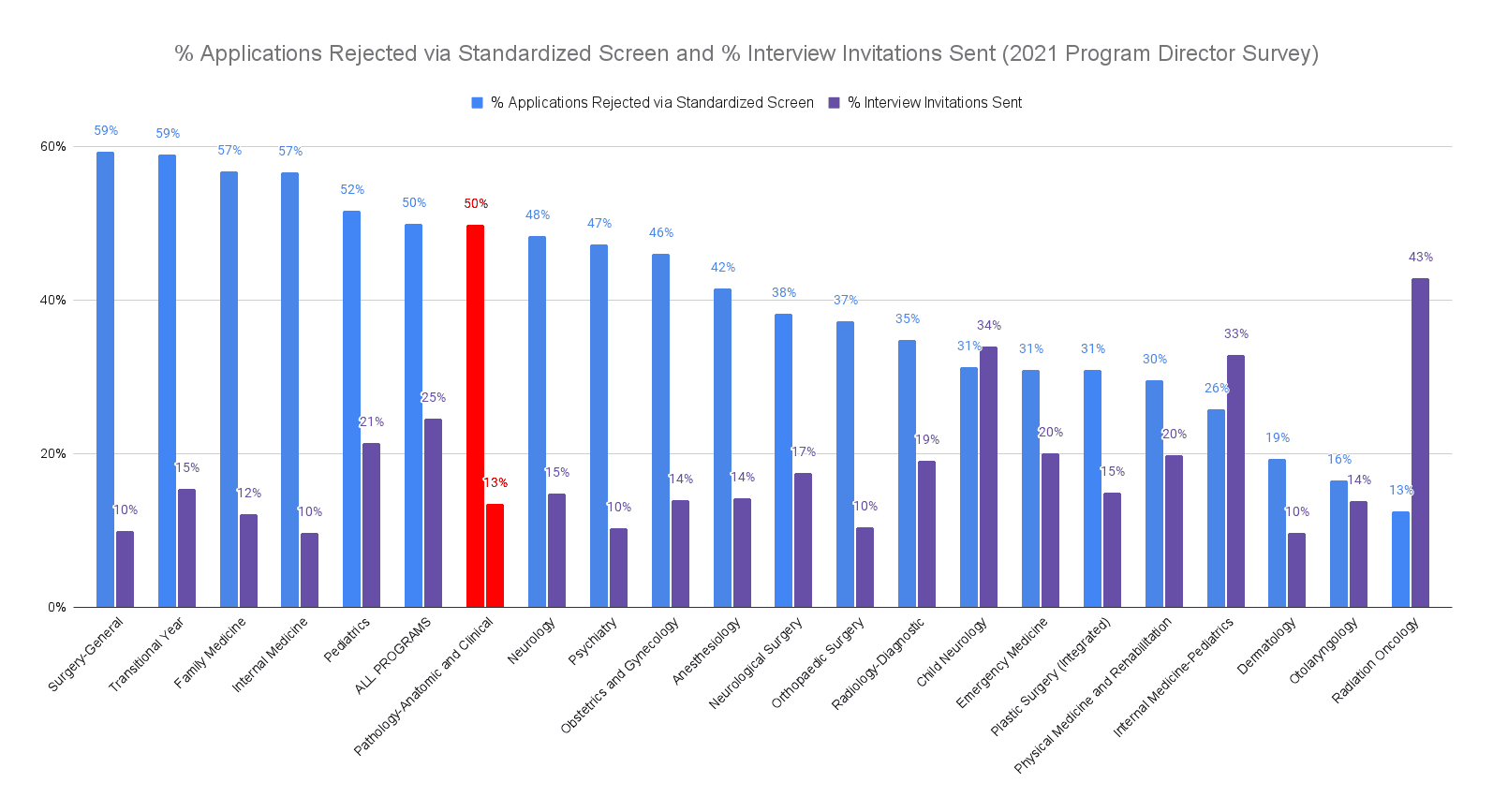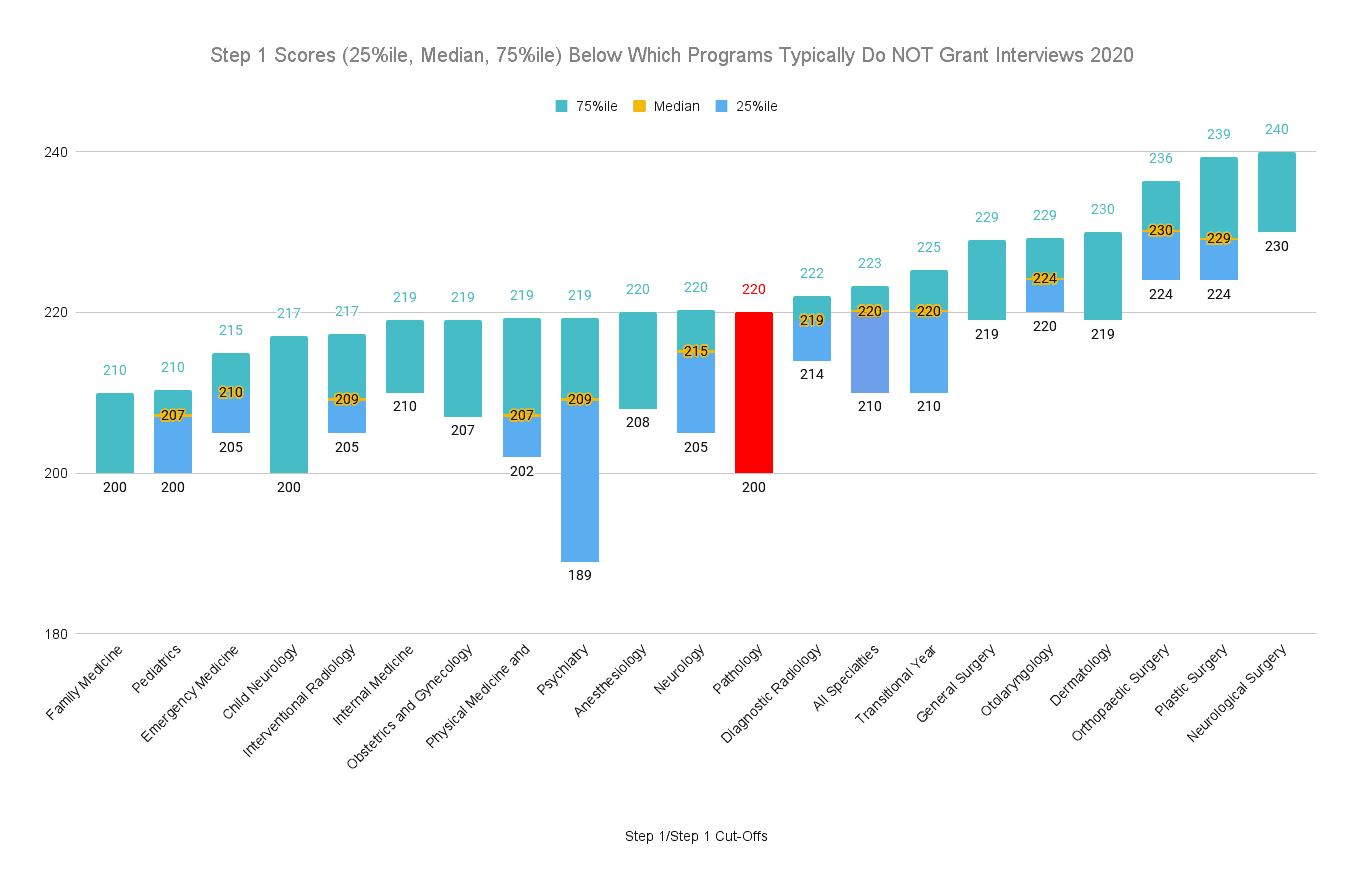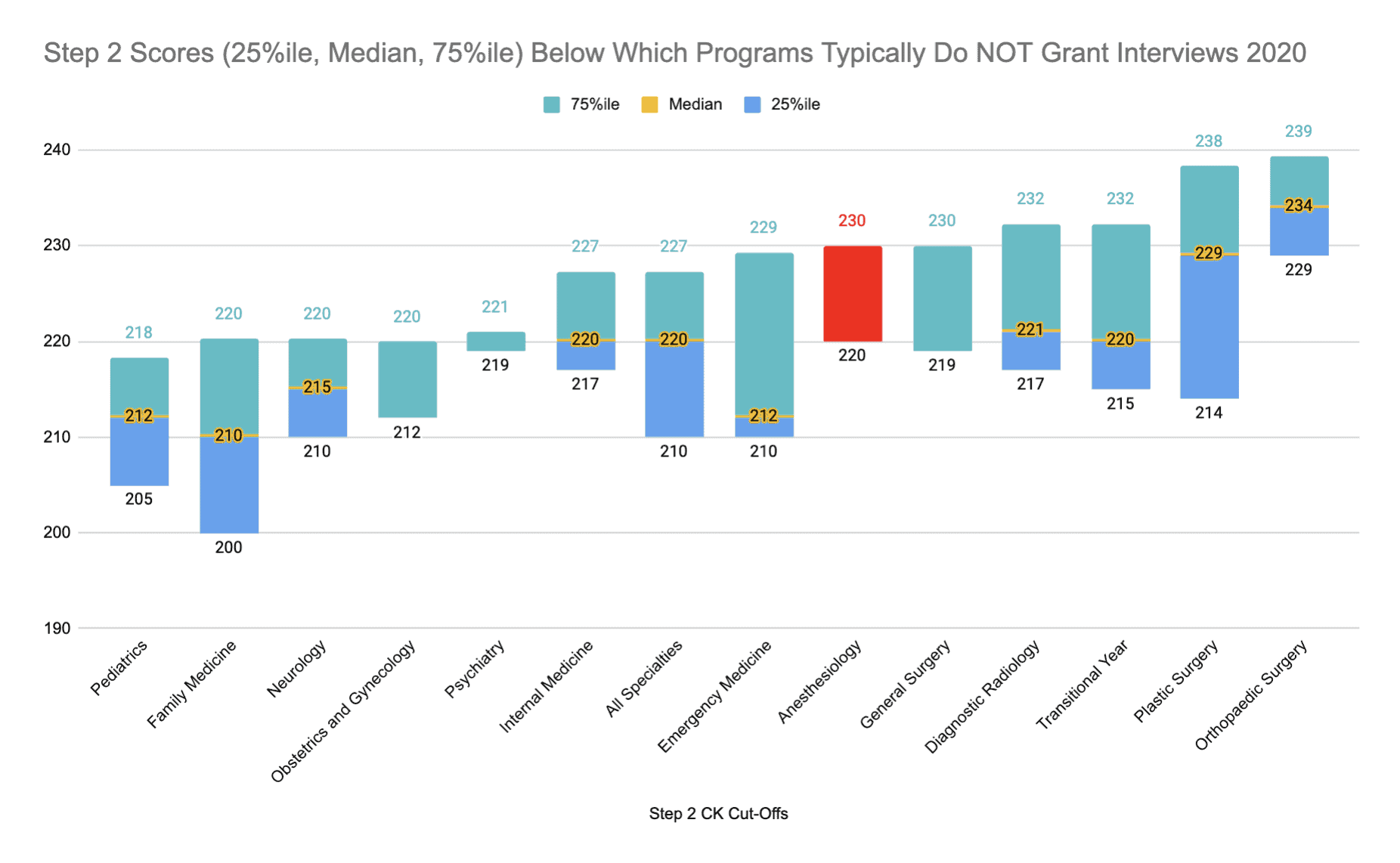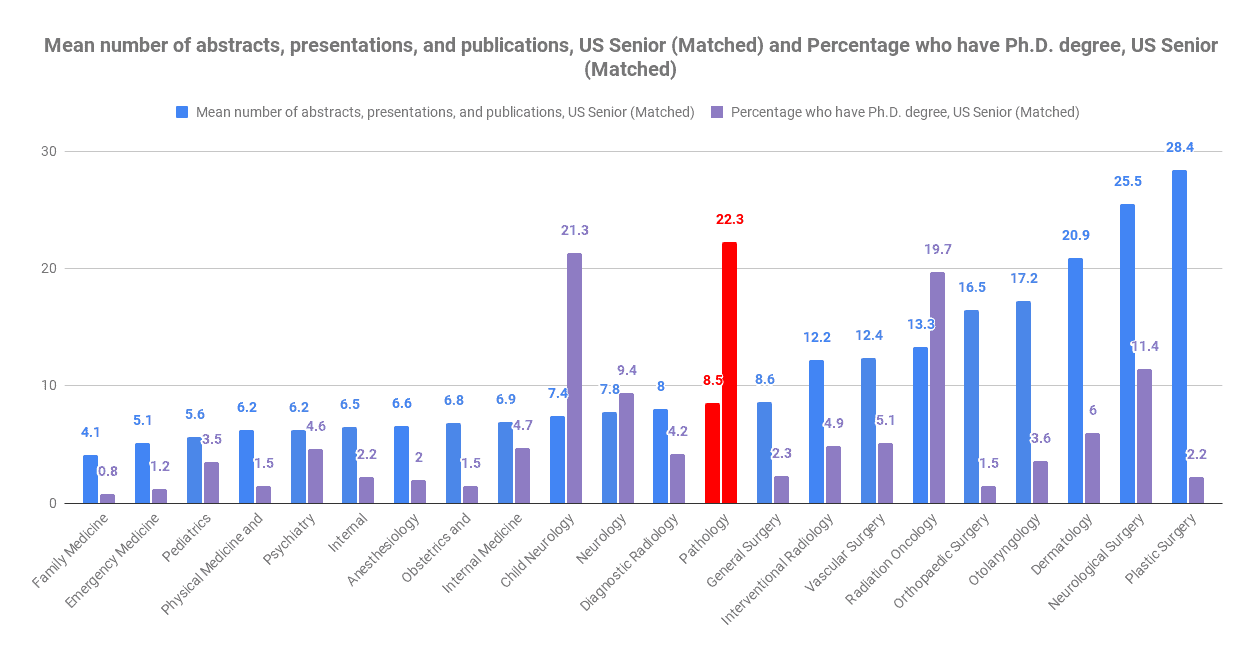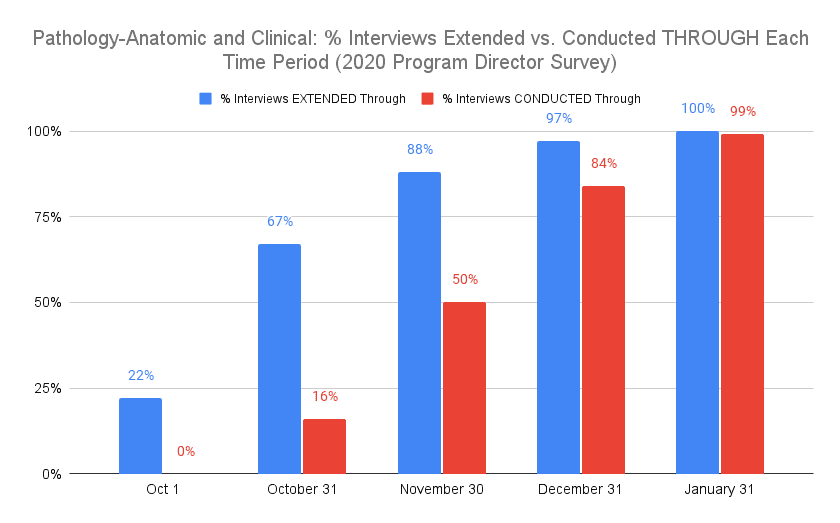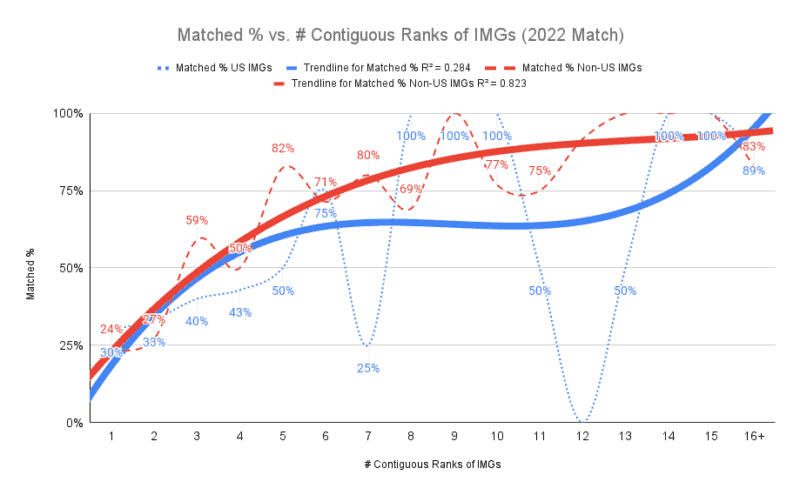
Are you wondering how to match into pathology? Or how many pathology residency programs are there? Do you want to know everything there is about pathology residency interviews? Need to know how many interviews to match in pathology?
In this article, you’ll learn everything you need to match into pathology.
Summary:
- Pathology is moderately competitive, in part due to having a high very high match rate for US seniors.
- In part due to the volume of applications, pathology residency programs use standardized screens to “weed out” applicants
- The most successful applicants will show perceived commitment, have a letter of recommendation, won’t fail any USMLE or COMPLEX-USA, and have good USMLE step 1 scores.
- Historically, most pathology interview invites occur before October 31, and the vast majority before December 31.
Table of Contents
How Competitive is it to Match into Pathology?
How competitive is it to match into pathology in the US? Here we have the unmatched % of US seniors by specialty. The “Unmatched%” indicates that 2.6% of US seniors who applied to pathology did not match during the given year.
This is one indicator of specialty competitiveness, and it may be the most relevant if you want to match into pathology.
For more on the competitiveness of pathology relative to other medical specialties, see this article.
How Many Pathology Residency Programs Are There?
Before we get into how many pathology residency programs there are in the United States, let’s review some terminology. Many specialized residency programs (e.g., anesthesiology, dermatology, radiology, radiation oncology, etc.) begin specialty training during the second year of residency. This second year is also known as the PGY-2 (post-graduate year 2, for the second year after graduating from medical school).
Categorical vs. Advanced vs. Physician Pathology Programs
Many programs have three different kinds of residency programs applicants can potentially enter: categorical, advanced, and physician (R). Pathology only offers categorical positions.
Programs classified as categorical include all years of residency training. Pathology residency is a four-year program. However, the first year of training is a “preliminary” year that can be internal medicine, surgery, or transitional medicine (a sort of grab-bag that will depend on the hospital). Some programs, known as “categorical” programs, include the PGY-1 “intern” year.
Others, on the other hand, require applicants to match into an intern year separately. These positions are referred to as “advanced” because they begin in the PGY-2 years.
Finally, those who have completed at least one year of residency training in pathology may be eligible for a “physician” pathology position. These positions allow applicants to skip the PGY-1 year and go straight into PGY-2 specialty training. This arrangement may be ideal for those who want to complete residency sooner and avoid repeating their intern year.
How Many Pathology Residency Programs and Positions Are There?
In the 2022 NRMP Match, there were:
- 168 pathology programs offering 631 PGY-1 (categorical) positions,
- No programs offering PGY-2 (advanced) positions, and
- No programs offering Physician (R) positions
As a result, there will be 631 pathology residency positions available in 2022. In 2022, there were at least 168 pathology programs. However, it is unknown how many more there were because many residency programs that offer advanced and/or physician positions also offer categorical ones.
See the 2022 Main Residency Match Results and Data for more information on pathology match statistics.
How to Match into Pathology: Impressing Program Directors
You must first be invited to an interview in order to match into pathology. PDs shared what they look for in candidates they hope to interview in the most recent program director (PD) survey from 2021.
According to program directors, the top five most important characteristics for receiving an interview in pathology were:
- Perceived commitment to the specialty
- Letters of recommendation in specialty
- Any failed USMLE attempt
- Any failed COMLEX-USA attempt
- USMLE Step 1 score
A table presents the same information in better detail. The percentage of program director respondents who cited a factor as important for granting an interview is shown here, as well as the mean importance score (out of 5).
A “composite score” was developed to balance the breadth of program directors citing each factor with the importance assigned to each factor. This composite score is calculated by averaging the percentage of respondents who mentioned a factor on a scale of 0 to 100%. For example, if 80% of PDs mentioned a given factor and it received a mean importance score of 5.0 (out of 5), the composite score would be 90%. (Average of 80% of PDs citing with 5/5 – or 100% – for mean importance, resulting in a composite score of 90%).
| Pathology-Anatomic and Clinical: Characteristics Considered in Deciding Whom to INTERVIEW (% of Respondents Endorsing) | Pathology-Anatomic and Clinical: Characteristics Considered in Deciding Whom to INTERVIEW (Mean Importance / 5) | Pathology-Anatomic and Clinical: Characteristics Considered for Interview Composite Score (Average of % Respondents Endorsing and Mean Importance / 5) | |
|---|---|---|---|
| Perceived Commitment to Specialty | 93.9% | 4.7 | 94.0% |
| Letters of Recommendation in Specialty | 93.9% | 4.5 | 92.0% |
| Any Failed USMLE Attempt | 87.9% | 4.6 | 90.0% |
| Any Failed COMLEX-USA Attempt | 81.8% | 4.6 | 86.9% |
| USMLE Step 1 Score | 97.0% | 3.8 | 86.5% |
| Personal Statement (Overall) | 93.9% | 3.9 | 86.0% |
| MSPE | 87.9% | 4 | 84.0% |
| USMLE Step 2 CK Score | 93.9% | 3.7 | 84.0% |
| Professionalism and Ethics | 69.7% | 4.5 | 79.9% |
| COMLEX-USA Level 1 score | 84.8% | 3.7 | 79.4% |
| Diversity Characteristics | 78.8% | 3.8 | 77.4% |
| COMLEX-USA Level 2 CE Score | 81.8% | 3.5 | 75.9% |
| Class Ranking/Quartile | 75.8% | 3.5 | 72.9% |
| Having Overcome Significant Obstacles | 69.7% | 3.8 | 72.9% |
| Personal Prior Knowledge of Applicant | 51.5% | 4.5 | 70.8% |
| Perceived Interest in Program | 54.5% | 4.3 | 70.3% |
| Consistency of Grades | 57.6% | 4.1 | 69.8% |
| Continuous Medical Education w/o Gaps | 57.6% | 4.1 | 69.8% |
| Grades in Required Clerkships | 63.6% | 3.5 | 66.8% |
| Leadership Qualities | 51.5% | 4.1 | 66.8% |
| Audition Elective/Rotation in PD's Dept | 42.4% | 4.5 | 66.2% |
| NRMP Flag for Match Violation | 36.4% | 4.8 | 66.2% |
| Passing USMLE Step 2 CS | 60.6% | 3.5 | 65.3% |
| Grades in Clerkship in Preferred Specialty | 45.5% | 4 | 62.8% |
| Away Rotation in Specialty Elsewhere | 39.4% | 4.3 | 62.7% |
| Medical School Accreditation Status | 39.4% | 4.2 | 61.7% |
| Other Life Experience | 45.5% | 3.8 | 60.8% |
| Awards/Honors in Clinical Clerkships | 54.5% | 3.3 | 60.3% |
| Passing COMLEX-USA Level 2 PE | 51.5% | 3.3 | 58.8% |
| Awards/Honors, Clerkship in Preferred Specialty | 42.4% | 3.7 | 58.2% |
| Volunteer/Extracurricular Experience | 45.5% | 3.5 | 57.8% |
| Involvement and Interest in Research | 48.5% | 3.3 | 57.3% |
| Medical School Reputation | 36.4% | 3.8 | 56.2% |
| Visa Status | 36.4% | 3.8 | 56.2% |
| Interest in Academic Career | 24.2% | 4.3 | 55.1% |
| Ability to Work Legally w/o Visa | 33.3% | 3.8 | 54.7% |
| Awards/Honors in Basic Sciences | 36.4% | 3.3 | 51.2% |
| AOA Membership | 39.4% | 2.9 | 48.7% |
| GHHS Membership | 30.3% | 3.2 | 47.2% |
| USMLE Step 3 Score | 33.3% | 2.9 | 45.7% |
| Fluency in Language of Pt Population | 18.2% | 3.5 | 44.1% |
| Sigma Sigma Phi Membership | 18.2% | 3.2 | 41.1% |
| COMLEX-USA Level 3 Score | 24.2% | 2.8 | 40.1% |
| How Medical School Handled Virtual Rotations | 6.1% | 2 | 23.1% |
Here are the composite scores for the criteria pathology program directors use for grading interviews.
What Do Pathology Program Directors Look for When Ranking Applicants?
Getting an interview is only one step in the pathology matching process. In order to create their rank order list, program directors rank the most 5 important factors.
Pathology program directors rated the following criteria as most important for deciding who to rank in the 2021 Program Director Survey:
- Interpersonal skills
- Interactions with faculty during interviews/visit
- Interactions with house staff during interview/visit
- Feedback from current residents
- Perceived commitment to the specialty
We can see the full list here:
| Pathology-Anatomic and Clinical: Characteristics Considered in Deciding Whom to RANK (% of Respondents Endorsing) | Pathology-Anatomic and Clinical: Characteristics Considered in Deciding Whom to RANK (Mean Importance / 5) | Pathology-Anatomic and Clinical: Characteristics Considered for Rank Composite Score (Average of % Respondents Endorsing and Mean Importance / 5) | |
|---|---|---|---|
| Interpersonal Skills | 100.0% | 4.9 | 99.0% |
| Interactions with Faculty During Interview/Visit | 93.9% | 4.8 | 95.0% |
| Interactions with House Staff During Interview/Visit | 93.9% | 4.8 | 95.0% |
| Feedback from Current Residents | 93.9% | 4.7 | 94.0% |
| Perceived Commitment to Specialty | 90.9% | 4.8 | 93.5% |
| Letters of Recommendation in Specialty | 84.8% | 4.4 | 86.4% |
| Perceived Interest in Program | 78.8% | 4.3 | 82.4% |
| Professionalism and Ethics | 72.7% | 4.6 | 82.4% |
| USMLE Step 1 Score | 81.8% | 4 | 80.9% |
| Any Failed USMLE Attempt | 69.7% | 4.6 | 80.9% |
| MSPE | 78.8% | 3.9 | 78.4% |
| Any Failed COMLEX-USA Attempt | 60.6% | 4.7 | 77.3% |
| USMLE Step 2 CK Score | 78.8% | 3.7 | 76.4% |
| COMLEX-USA Level 1 score | 72.7% | 4 | 76.4% |
| Diversity Characteristics | 69.7% | 4.1 | 75.9% |
| Personal Statement | 72.7% | 3.8 | 74.4% |
| Personal Prior Knowledge of Applicant | 60.6% | 4.4 | 74.3% |
| Leadership Qualities | 57.6% | 4.2 | 70.8% |
| COMLEX-USA Level 2 CE Score | 66.7% | 3.7 | 70.4% |
| Continuous Medical Education w/o Gaps | 51.5% | 4 | 65.8% |
| Class Ranking/Quartile | 60.6% | 3.5 | 65.3% |
| Having Overcome Significant Obstacles | 51.5% | 3.9 | 64.8% |
| NRMP Flag for Match Violation | 33.3% | 4.8 | 64.7% |
| Audition Elective/Rotation in PD's Dept | 42.4% | 4.2 | 63.2% |
| Consistency of Grades | 45.5% | 3.7 | 59.8% |
| Passing USMLE Step 2 CS | 45.5% | 3.7 | 59.8% |
| Medical School Accreditation Status | 39.4% | 3.9 | 58.7% |
| Away Rotation in Specialty Elsewhere | 33.3% | 4.2 | 58.7% |
| Grades in Required Clerkships | 45.5% | 3.5 | 57.8% |
| Grades in Clerkship in Preferred Specialty | 36.4% | 3.8 | 56.2% |
| Interest in Academic Career | 36.4% | 3.8 | 56.2% |
| Passing COMLEX-USA Level 2 PE | 39.4% | 3.6 | 55.7% |
| Medical School Reputation | 36.4% | 3.6 | 54.2% |
| Fluency in Language of Patient Population | 21.2% | 4.3 | 53.6% |
| Other Life Experience | 33.3% | 3.6 | 52.7% |
| Volunteer/Extracurricular Experience | 33.3% | 3.6 | 52.7% |
| Involvement and Interest in Research | 33.3% | 3.6 | 52.7% |
| Other Post-Interview Contact | 24.2% | 4 | 52.1% |
| Visa Status | 24.2% | 3.9 | 51.1% |
| Awards/Honors in Clinical Clerkships | 33.3% | 3.3 | 49.7% |
| Ability to Work Legally w/o Visa | 15.2% | 4.2 | 49.6% |
| Second Interview/Visit | 15.2% | 4.2 | 49.6% |
| Awards/Honors, Clerkship in Preferred Specialty | 30.3% | 3.4 | 49.2% |
| Applicant Facility with Meeting Platform Tech | 18.2% | 3.7 | 46.1% |
| AOA Membership | 27.3% | 3.1 | 44.7% |
| Awards/Honors in Basic Sciences | 27.3% | 3 | 43.7% |
| USMLE Step 3 Score | 24.2% | 3 | 42.1% |
| GHHS Membership | 12.1% | 3.3 | 39.1% |
| Sigma Sigma Phi Membership | 9.1% | 3.3 | 37.6% |
| COMLEX-USA Level 3 Score | 18.2% | 2.8 | 37.1% |
| How Medical School Handled Virtual Rotations | 0.0% | 0.0% |
Finally, we can see the composite scores for criteria used to rank pathology applicants.
What Characteristics Do Successful Pathology Applicants Share?
Here are the characteristics of matched vs. unmatched US seniors applying to pathology.
| Matched | Unmatched | |
|---|---|---|
| Mean number of contiguous ranks, US Senior | 12.6 | 3 |
| Mean number of distinct specialties ranked, US Senior | 1.1 | 1.3 |
| Step 1, US Senior | 233 | 226 |
| Step 2, US Senior | 245 | 232 |
| Mean number of research experiences, US Senior | 3.4 | 3 |
| Mean number of abstracts, presentations, and publications, US Senior | 8.5 | 1.7 |
| Mean number of work experiences, US Senior | 3.2 | 2.3 |
| Mean number of volunteer experiences, US Senior | 6 | 5.3 |
| Percentage who are AOA members, US Senior | 11 | 0 |
| Percentage who graduated from one of the 40 U.S. medical schools with the highest NIH funding, US Senior | 30.9 | 0 |
| Percentage who have Ph.D. degree, US Senior | 22.3 | 0 |
| Percentage who have another graduate degree, US Senior | 17.2 | 33.3 |
Match Into Pathology: Pass the Screens with High USMLEs
Pathology employs standardized screening procedures to weed out applicants. Pathology PDs reported that 13% of interview invitations were sent and 50% of applications were rejected via the standardized screen in the 2021 Program Director Survey. This was near the middle of the list of residencies.
What Are the Step 1 and Step 2 CK Cut-Offs for Interviews in Pathology?
As mentioned above, pathology ranks near the middle of programs using standardized screens to eliminate applications. Many pathology programs reject applicants who have failed the USMLE Step 1 and Step 2 CK (see below). Furthermore, PDs use Step 1 and Step 2 CK score cut-offs to remove applicants.
Pathology program directors reported Step 1 score cut-offs of 200 to 220 as 25% and 75%ile marks to screen out applicants for Step 1.
The graphs do not include Step 2 CK scores. This is not because the scores are lower than expected; rather, it is due to a lack of data.
For more on the USMLE cut-off scores for granting interviews – or weeding out applicants – see this article.
If I Fail Step 1, Can I Still Match Into Pathology?
If you did not pass Step 1, you may be wondering if you can still match into pathology. According to the most recent program director survey addressing this question, pathology programs are relatively unforgiving if Step 1 is failed.
In 2020, pathology 21% of PDs reported they “never” consider applicants who fail Step 1, while 54% would “seldom” consider it. Only 25% of pathology programs “often” consider someone with a Step 1 fail.
Did you fail Step 1 and are wondering what you can do to recover? Read this article and consider scheduling a consultation.
If I Fail Step 2 CK, Can I Still Match Into Pathology?
Similarly, if you fail Step 2 CK, you may wonder what your chances of matching into pathology are. Pathology PDs, like Step 1 PDs, are relatively unforgiving for failing Step 2 CK.
In 2020, pathology 26% of PDs reported they “never” consider applicants who fail Step 2 CK, while 48% would “seldom” consider it. Only 26% of pathology programs “often” consider someone with a Step 2 CK fail.
Did you fail Step 2 CK and wonder what you can do to recover? Read this article and consider scheduling a consultation.
How Many Publications for Pathology Residency in 2022
Many specialties, particularly the most competitive, value research as an important characteristic for matching. So, how many publications are required to be accepted into a pathology residency?
The mean number of abstracts, presentations, and publications for US seniors matched into pathology in 2022 was 8.5. The mean number of research opportunities was 3.4.
Do I Need an MD-PhD to Become a Pathologist?
You may be wondering how much an MD-PhD helps with pathology matching. When applying to pathology, it appears that having a PhD correlates with a 2% advantage. When applying to pathology, those with a PhD have a 100% higher match rate than those without one.
Note that those with PhDs are relatively common among pathology residents. Over 22.3% of matched applicants to pathology had a PhD and a mean number of abstracts, presentations, and publications, US senior of 8.5% in 2022. This shows the considerable academic investment necessary to become a successful pathologist, emphasizing the importance and value of a PhD.
Pathology Residency Interviews
When applying to pathology, you may wonder what your chances are of getting an interview. The results of the 2021 NRMP Program Director Survey are presented here.
Note that pathology uses standardized screens to reduce the number of applicants. Roughly 50% of applicants that year were eliminated via a screen (e.g., Step 2 CK scores, visa status, failed a USMLE in the past, etc.).
When Are Pathology Residency Interview Invites Sent vs. Conducted?
When you apply for residency, you will have to wait a long time. You will be waiting to hear whether or when you will be invited for an interview.
Do you want to know when pathology programs will contact you about your residency application? This is when most programs extend and conduct interviews. Note that the most recent data are from 2020.
Here are the same data presented differently. Note that due to rounding, sometimes the percentages can add up to more than 100%.
How Many Interviews to Match in Pathology?
How many interviews in pathology to match with confidence? For US seniors, the magic number of interviews required to match into a pathology residency ranges from 1 to 5. Having 5 interviews (and ranking them all on their match list) resulted in a 100% chance of matching in 2022. To ensure success in the match, US seniors should aim for as many interviews as possible: 5. This number of interviews proved to be sufficient to ensure a match for the 2022 class.
How Many Interviews to Match in Pathology as a DO?
For DO seniors, more interviews were necessary to match into pediatrics comfortably. To get to the >75% threshold, ≥ 4 interviews were needed. From the graph below we can see that DOs with more interviews were nearly guaranteed to match.
How Many Interviews to Match in Pathology as an IMG?
More interviews, similar to DOs, were required for IMGs to comfortably match into pathology. ≥ 5-9 interviews were required to reach the 75% threshold. As the number of interviews increases, the numbers become significantly “noisier” and cannot be interpreted with much confidence.
Concluding Thoughts
Matching into pathology is a challenging proposition. The challenge may feel more daunting if we have perceived weaknesses in our application, or if we want to match in a top program, a desirable location, and/or couples match.
The good news? How to match into pathology depends largely on things you can control – your USMLEs, your clinical performance/MSPEs, whether you fail Step 1 or Step 2 CK, and how much interest you show in programs.
Looking for a Pathology Residency Advisor?
Looking for a pathology residency advisor? Want help writing your personal statement? Need effective strategies for interviewing? Do you have things on your application – e.g., low USMLE scores, failed USMLEs, no research, IMG status, or others – you need help overcoming?
Be sure to check out our Residency Advisor service.




